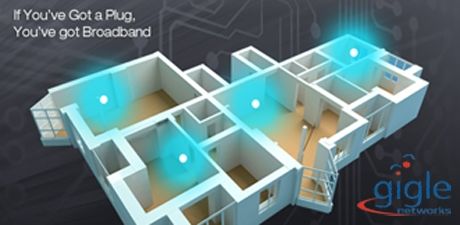The Power Line Communications (PLC) networking technology allows users to establish a fast, wired network within the home to interconnect the network devices among them and to Internet using the existing electrical wiring as the medium. Neither new wires and drilling holes in the wall, nor knowledge of the networking technology are necessary, making installation quick, easy, and less expensive 
PLC adapters convert any electrical plug in a network port. Moreover, this technology can be naturally embedded in AC-powered devices with no standalone adapters, creating an “invisible network”. These devices include power control centers, IP security cameras, TVs, set-top boxes, DVRs, and other such consumer electronics.
One of the largest challenges posed for the PLC technology was the way to combat the electrical noise that would be around due to the use of a power outlet to transfer information efficiently. Whenever any appliance is turned on or turned off it creates impulsive noise that could possibly disrupt data transfer. Common household appliances like computers or hair dryers, can cause colored background noise up to 30 MHz. Broadcast radio stations produce narrowband interferences in the frequency range of 1-22 MHz. Finally, the rectifiers and the switching power supplies found in various household appliances today cause periodic impulsive noise. To transmit data effectively in such a noise channel the PLC devices employ adaptive modulation on hundreds OFDM sub-carriers, turbo convolution codes for error correction, two-level MAC framing with ARQ and other techniques.
Another problem recently solved was the lack of standardization in the market for PLC products and technologies. With the ratification of the IEEE 1901 standard on September 30th 2010, the HomePlug, which is the most widely deployed technology, has been validated by IEEE. The three major specifications published by HomePlug (HomePlug AV, HomePlug Green PHY and the developing HomePlug AV2) are all compliant to IEEE 1901. Moreover, the HomePlug Powerline Alliance will be the certifying body for IEEE 1901 products.
The HomePlug AV specification, introduced in August 2005, provides up to 200 Mbps physical transmission rate. Nevertheless, the Spanish company, Gigle Networks, a board member of the HomePlug Powerline Alliance and an active participant in IEEE P1901 standardization activities is reported to be the first company to bring to market a PLC capable of delivering 1Gbps by using their Mediaxtream technology while remaining fully compliant to and interoperable with all certified HomePlug AV/IEEE 1901 products.
The Gradiant interest in these technologies is reflected in the signature of a development and license agreement with Gigle Networks in order to develop applications and to provide support to third parties willing to work with Gigle’s technology. Moreover, Gradiant and Gigle collaborate in several projects. The Gigaconnectivity Lab project, funded by Plan Avanza I+D, aims to develop a PLC test laboratory remotely available. Using virtualization technologies, the developed server emulates the computers present in a home network and a noise generator synthesizes the interferences caused by electrical devices in a real installation. The test scenario is remotely configurable and accessible and reflect the different aspects of the subject sites, as well as network infrastructure commonly found in them and signs that interact within. The underlying idea is to generate a testing ground for the development of new products, applications and services in the field of home networks for telecommunications, where manufacturers and developers of services and applications may undertake their own development in realistic and reliable scenarios with controlled environment. As a result, new test and validation methods can be used, reducing time and cost required from when a new item or service is validated in a research laboratory until their result is applicable in the market.


